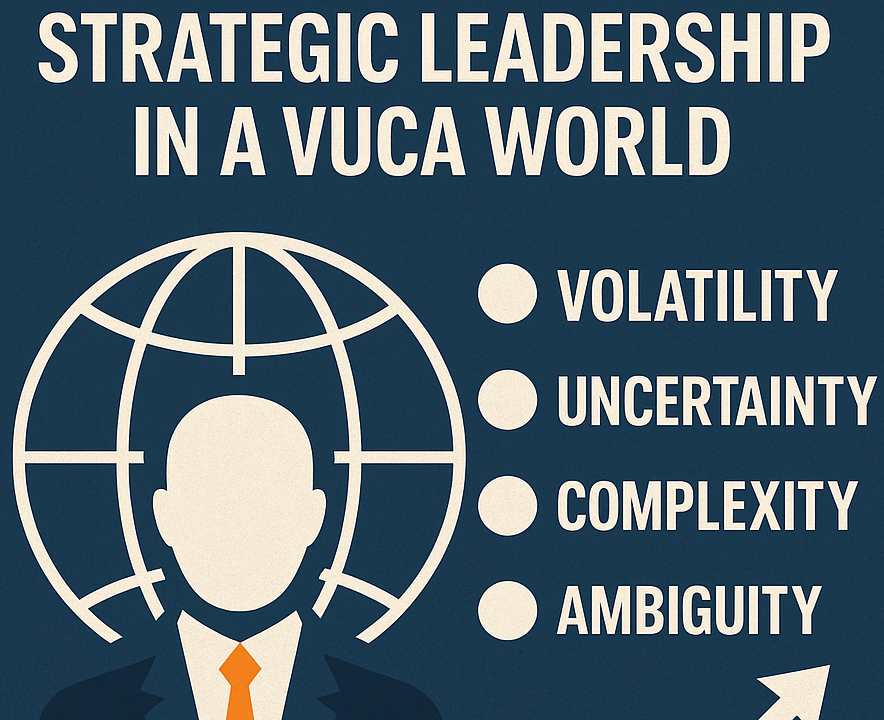
Why Vision Is a Cornerstone of Strategic Leadership
July 17, 2025
Spirit of the Current
July 20, 2025In today’s volatile and interconnected world, strategic leadership is more than a title; it’s a dynamic capability grounded in conceptual agility, political savvy, and interpersonal fluency. While traditional leadership focuses on managing people and resources, strategic leadership requires envisioning future realities, managing change, and navigating complex and uncertain environments. The competencies that define a strategic leader are not innate traits; they are learnable, experience-driven capabilities that emerge over time through reflection, exposure, and intentional development.
The Triad of Strategic Leadership Competence
Strategic leader competencies can be categorized into three interdependent areas: conceptual, technical, and interpersonal. Together, they equip leaders to understand the big picture, influence across systems, and move organizations toward long-term success.
- Conceptual Competencies: Thinking Beyond the Obvious
Strategic environments are defined by complexity, ambiguity, and competing interests. Leaders operating in this space must be able to:
•
Develop a Strategic Frame of Reference: This is the leader’s internal map of the strategic world, developed through learning, reflection, and diverse experiences. A strong frame of reference allows leaders to see connections others miss, anticipate second- and third-order effects, and assess risks and opportunities with nuance.
•
Manage Strategic Problems: Strategic leaders face dilemmas that don’t have clear correct answers, often choosing between “right vs. right” rather than “right vs. wrong.” They must approach these as systems, weigh trade-offs, and remain adaptable under conditions of uncertainty.
•
Envisioning the Future: Perhaps the most essential competency, envisioning the future means setting direction, formulating long-term aims, and aligning resources around a compelling vision. Strategic leaders shape the environment rather than simply reacting to it. - Technical Competencies: Understanding the Systems at Play
At the strategic level, technical knowledge moves beyond the functional. Leaders must:
•
Understand Organizational Systems: Strategic leaders need a holistic understanding of how their organization fits within broader systems, including government, economic, and cultural frameworks.
•
Operate Across Boundaries: Proficiency in working with Joint, Interagency, Intergovernmental, and Multinational (JIIM) partners is essential, especially in global organizations. Strategic leaders must be culturally fluent and politically aware.
•
Navigate Political and Social Contexts: Effective strategy requires engagement with policymakers, stakeholders, and external influencers. Leaders must understand how to frame arguments, build effective coalitions, and advocate for resources in complex and dynamic environments. - Interpersonal Competencies: Influencing Without Authority
Influence, not authority, is the currency of strategic leadership. Core interpersonal skills include:
•
Consensus Building: Strategic leaders often work laterally with peers, external partners, and cross-functional teams. They must create alignment around shared goals, even when priorities differ.
•
Negotiation: Many strategic decisions involve stakeholders with competing agendas. Strategic leaders must know when to stand firm, when to compromise, and how to balance maintaining relationships with advancing outcomes.
•
Communication: Clear, consistent, and persuasive communication is vital. Strategic leaders must articulate a clear vision, convey complex ideas, and shape meaning through both words and actions.
The Inner Engine: Strategic Thinking, Political Savvy, and Change Leadership
According to Norzailan et al. (2016), three critical capabilities drive strategic leadership effectiveness:
•
Strategic Thinking: Leaders must engage in hypothesis-driven, creative thinking to drive effective decision-making. This requires “thinking in time”, connecting past, present, and future, and having a systems perspective.
•
Managing Politics and Alliances: Organizations are social systems with competing interests. Strategic leaders must develop political skills to influence, build trust, and mobilize informal networks.
•
Change Management: Strategic intent is meaningless without implementation. Effective leaders communicate change, mobilize people, and evaluate progress in environments filled with ambiguity and resistance.
Developing Strategic Leader Competence
Competencies are not taught; they are developed through rich, intentional experiences. The most effective development programs use a “developmental triangle” approach:
1.
Deliberate Practice: Real-world assignments that stretch capabilities and allow for learning through mistakes. Development is most effective when it follows the 70:20:10 rule: 70% experiential, 20% coaching/mentorship, 10% formal training.
2.
Experience Density: Exposure to complexity and stress builds judgment and resilience. Leaders grow when they face ambiguous, high-stakes challenges and must navigate them under pressure.
3.
Reflective Learning: Insight is not automatic; it must be cultivated through structured reflection, feedback, and self-assessment. Leaders must revisit their experiences, test assumptions, and develop new ways of thinking.
Culture Matters: The Case of Unilever in Russia
Van Beek and Grachev’s (2010) study of Unilever’s leadership development in Russia illustrates the need for strategic competencies to be culturally adaptive. Unilever’s Leadership Growth Profile (LGP) emphasized global competencies such as “holding people accountable,” “building trust,” and “seizing the future.” However, their effectiveness varied across cultural contexts.
For instance, Russian managers emphasized accountability and relationship-building but deprioritized competencies such as team leadership or future orientation, reflecting the cultural dimensions of high power distance and low uncertainty avoidance. Unilever responded by tailoring leadership programs to local contexts while maintaining alignment with global strategy. This case highlights the importance of contextual intelligence, the ability to adapt leadership to local conditions while driving global outcomes.
Conclusion: Competence Is the Strategy
In the strategic realm, leadership is not just about influence; it is about foresight, systems thinking, and the ability to shape outcomes across interconnected domains. Strategic leader competencies are not static attributes, but rather dynamic capabilities developed through disciplined reflection, stress-tested experiences, and adaptive learning.
As the world becomes more interconnected and unpredictable, organizations must invest in building these competencies, not just at the top, but throughout their leadership pipelines. Ultimately, competence is the fundamental strategy, and strategic leaders are the ones who bring it to life.
References
Department of the Army. (2019). Strategic Leadership Primer (3rd ed.). U.S. Army War College.
https://publications.armywarcollege.edu/pubs/3667.pdf
Norzailan, Z., Yusof, S. M., & Othman, R. (2016). Developing strategic leadership competencies. Journal of Advanced Management Science, 4(1), 66–71. https://doi.org/10.12720/joams.4.1.66-71
Van Beek, M. A., & Grachev, M. V. (2010). Leadership development at Unilever in Russia: A strategic partnership perspective of a transitional economy. Journal of Strategic and International Studies, 5(3), 40–51.
Schoemaker, P. J. H., Krupp, S., & Howland, S. (2013). Strategic leadership: The essential skills. Harvard Business Review, 91(1–2), 131–134. https://hbr.org/2013/01/strategic-leadership-the-essential-skills
Yukl, G. (2013). Leadership in organizations (8th ed.). Pearson Educatio


